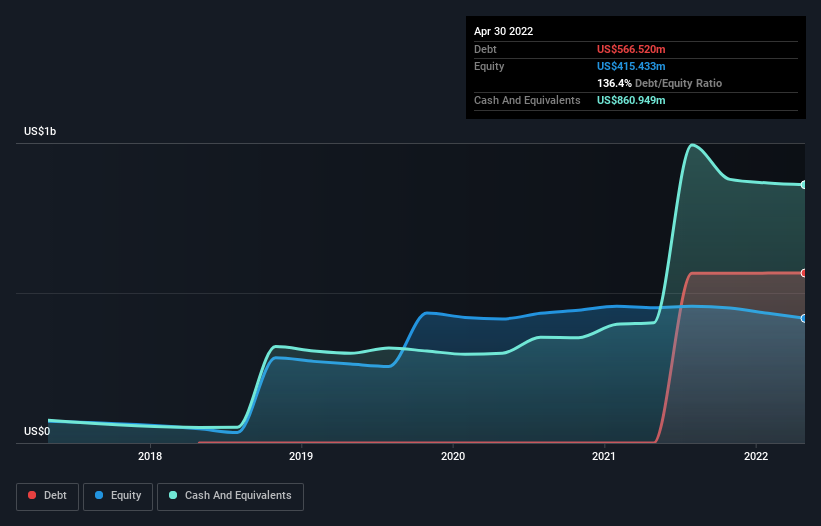Health Check: How Prudently Does Elastic (NYSE:ESTC) Use Debt?
The external fund manager backed by Berkshire Hathaway's Charlie Munger, Li Lu, makes no bones about it when he says 'The biggest investment risk is not the volatility of prices, but whether you will suffer a permanent loss of capital.' When we think about how risky a company is, we always like to look at its use of debt, since debt overload can lead to ruin. Importantly, Elastic N.V. (NYSE:ESTC) does carry debt. But is this debt a concern to shareholders?
When Is Debt A Problem?
Debt is a tool to help businesses grow, but if a business is incapable of paying off its lenders, then it exists at their mercy. Part and parcel of capitalism is the process of 'creative destruction' where failed businesses are mercilessly liquidated by their bankers. However, a more common (but still painful) scenario is that it has to raise new equity capital at a low price, thus permanently diluting shareholders. Of course, the upside of debt is that it often represents cheap capital, especially when it replaces dilution in a company with the ability to reinvest at high rates of return. When we examine debt levels, we first consider both cash and debt levels, together.
View our latest analysis for Elastic
How Much Debt Does Elastic Carry?
As you can see below, at the end of April 2022, Elastic had US$566.5m of debt, up from none a year ago. Click the image for more detail. But on the other hand it also has US$860.9m in cash, leading to a US$294.4m net cash position.
A Look At Elastic's Liabilities
Zooming in on the latest balance sheet data, we can see that Elastic had liabilities of US$593.3m due within 12 months and liabilities of US$634.2m due beyond that. Offsetting these obligations, it had cash of US$860.9m as well as receivables valued at US$215.2m due within 12 months. So its liabilities outweigh the sum of its cash and (near-term) receivables by US$151.3m.
Having regard to Elastic's size, it seems that its liquid assets are well balanced with its total liabilities. So while it's hard to imagine that the US$8.33b company is struggling for cash, we still think it's worth monitoring its balance sheet. Despite its noteworthy liabilities, Elastic boasts net cash, so it's fair to say it does not have a heavy debt load! When analysing debt levels, the balance sheet is the obvious place to start. But ultimately the future profitability of the business will decide if Elastic can strengthen its balance sheet over time. So if you want to see what the professionals think, you might find this free report on analyst profit forecasts to be interesting.
Over 12 months, Elastic reported revenue of US$862m, which is a gain of 42%, although it did not report any earnings before interest and tax. With any luck the company will be able to grow its way to profitability.
So How Risky Is Elastic?
Statistically speaking companies that lose money are riskier than those that make money. And in the last year Elastic had an earnings before interest and tax (EBIT) loss, truth be told. And over the same period it saw negative free cash outflow of US$1.7m and booked a US$204m accounting loss. But the saving grace is the US$294.4m on the balance sheet. That means it could keep spending at its current rate for more than two years. Elastic's revenue growth shone bright over the last year, so it may well be in a position to turn a profit in due course. Pre-profit companies are often risky, but they can also offer great rewards. The balance sheet is clearly the area to focus on when you are analysing debt. But ultimately, every company can contain risks that exist outside of the balance sheet. For instance, we've identified 4 warning signs for Elastic (1 is a bit unpleasant) you should be aware of.
If, after all that, you're more interested in a fast growing company with a rock-solid balance sheet, then check out our list of net cash growth stocks without delay.
Have feedback on this article? Concerned about the content? Get in touch with us directly. Alternatively, email editorial-team (at) simplywallst.com.
This article by Simply Wall St is general in nature. We provide commentary based on historical data and analyst forecasts only using an unbiased methodology and our articles are not intended to be financial advice. It does not constitute a recommendation to buy or sell any stock, and does not take account of your objectives, or your financial situation. We aim to bring you long-term focused analysis driven by fundamental data. Note that our analysis may not factor in the latest price-sensitive company announcements or qualitative material. Simply Wall St has no position in any stocks mentioned.
Join A Paid User Research Session
You’ll receive a US$30 Amazon Gift card for 1 hour of your time while helping us build better investing tools for the individual investors like yourself. Sign up here

 Yahoo Finance
Yahoo Finance 
